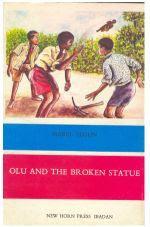



A champion for children's literature in Nigeria, Segun founded the Children's literature Association of Nigeria in 1978 and set up the Children's Documentation and Research Centre in 1990 in Ibadan. In an interview Mabel Segun did with Wale Okediran, Okediran asked Segun 'what's all this fuss about training workshops' with reference to writing for children as it's 'no big deal'. To which Segun responds:
... writing for children is much more difficult than writing for adults. Children at different ages have different interests, different psychological make-ups and different cognitive experiences. You must use simple language and you must never talk down to children.

Image via Preserving the Landscape of Imagination
In addition, Segun's biography includes being a fellow at the International Youth Library in Munich, on the children's books review panel for African Book Publishing Record published in Oxford, an assessor for the Noma Award for Publishing in Africa and a collaborator with the International Board on Books for Young People in Basel. In 2007, Segun's play for children - Readers' Theatre: Twelve Plays for Young People was joint winner of theN LNG Nigeria Prize for Children's Literature. The twelve plays include popular folktales, as well as ones on Nigerian heroes.
Finally, while my celebration focuses on works published since 1960, I had to share this fascinating excerpt from Segun's interview with Wale Okediran on 'who should rightly be called the first published female writer in Nigeria':
Flora Nwapa is not the first published Nigerian female writer. In 'Nigerian Women in the Arts', Phebaan Itayemi, now Phebean Ogundipe, has this distinction. Her short story, which won a British Council competition in 1946, was published in an anthology ... I am the second Nigerian female to be published abroad. In 1954, twelve years before Heinemann published Flora's first novel, 'Efuru' (1966), three poems were translated into German and published in a German anthology, 'Shwarzer Orpheus'. In 1958, one poem and a short story were similarly published in another German anthology. Before these foreign anthologies were published, I contributed short stories, poems and essays to the Ibadan University College magazine, the 'University Herald' (1950-54). In 1962, I was the only female writer included in 'Reflections' - still before Flora's debut with her novel. In these early days, poetry and short stories were usually published in anthologies. Single author collections were rare.

